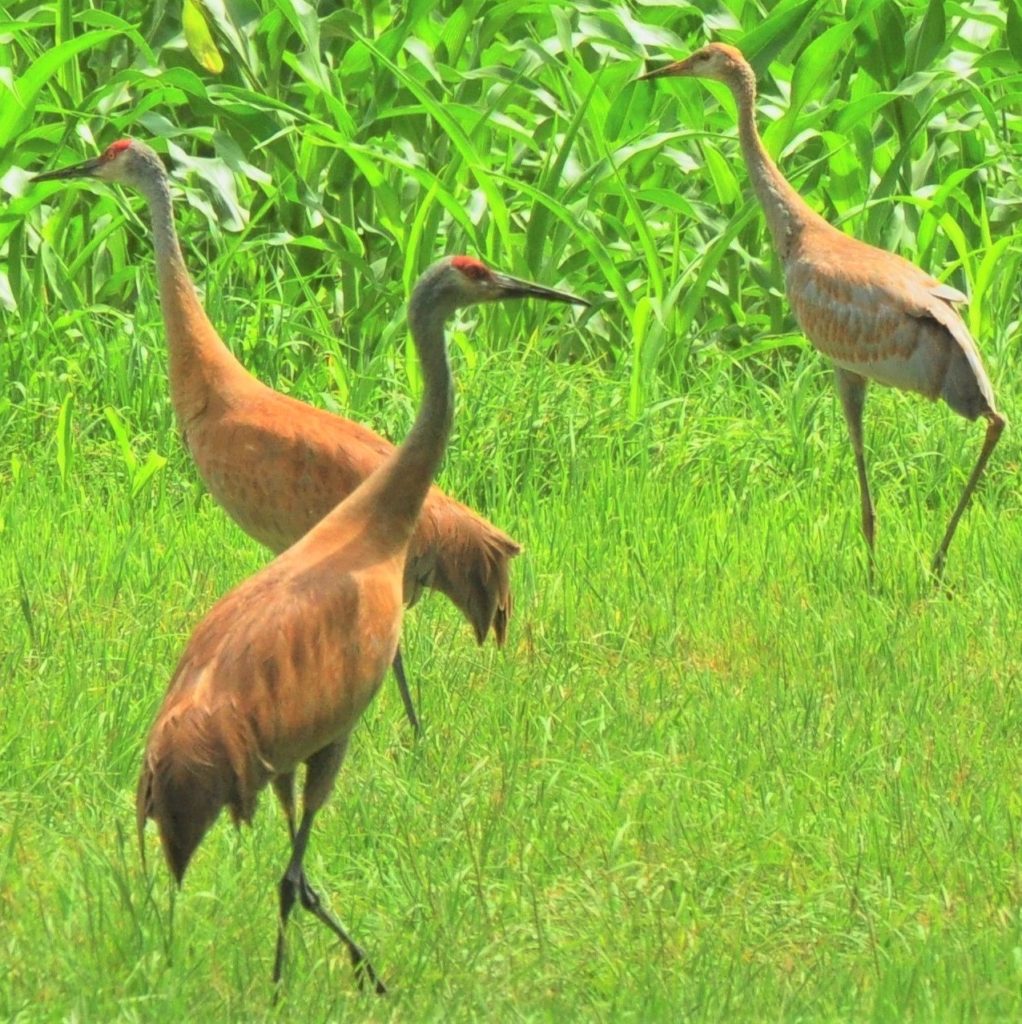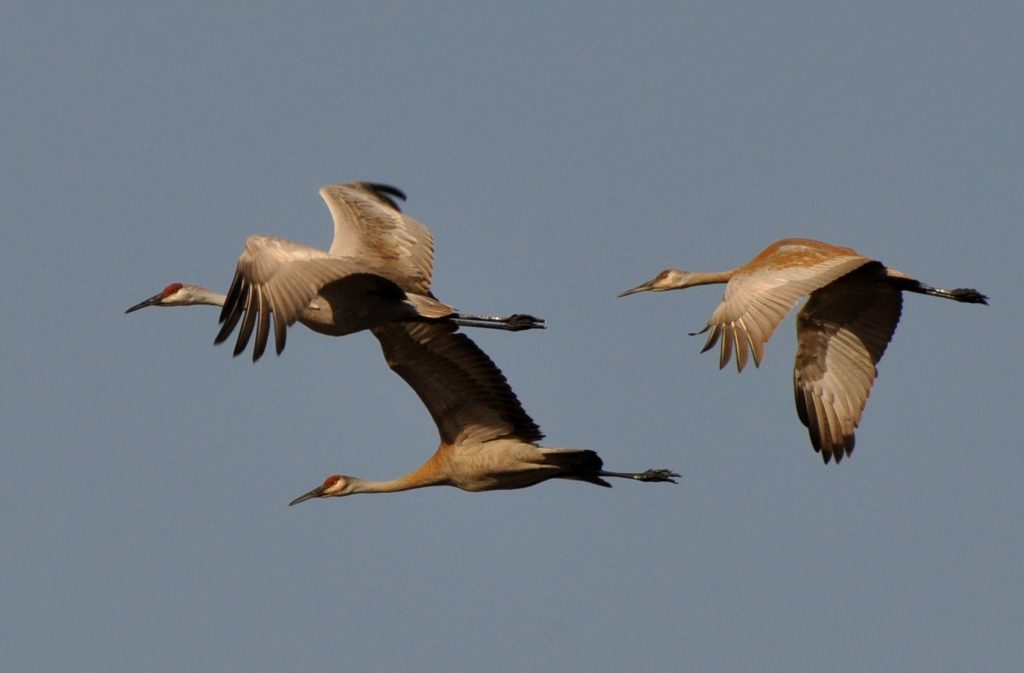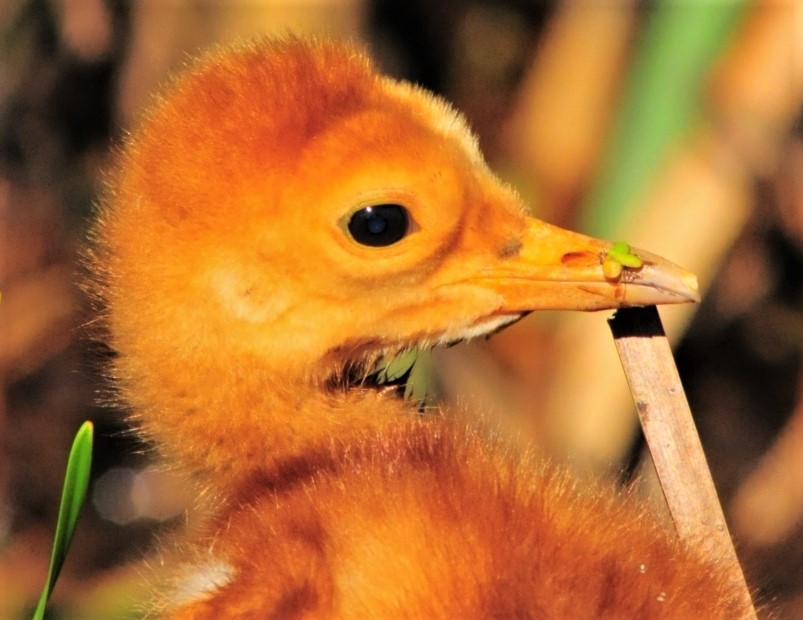Photography courtesy of Lowell Washburn, all rights reserved.
Following months of austere reclusion, resident families of sandhill cranes are beginning to appear. Stealthily prowling marsh edge, cow pasture, and bean field; crane parents are busily teaching youngsters – more properly called crane colts — the useful art of frog spearing. Learning to successfully hunt frogs, snakes, and other edible creatures is a trial and error process that will eventually allow juvenile sandhills to survive on their own.

With its penetrating stare, ear piercing call, six-foot wingspan, and four-foot height; the crimson-capped sandhill crane is about as impressive as a wild bird can get. Credited with having the loudest voice of any bird species, the crane’s rolling elephant-like bugling can be heard for miles. During spring courtship, crane pairs conduct charismatic rituals in which birds engage in flamboyant unison calling, simultaneous bowing, and elaborate wing extensions before executing a perfectly synchronized, dramatically choreographed nuptial dance. Extremely wary, nesting adults stay as far from humans as possible. Their nest sites and newly hatched young are rarely observed.

Wild cranes were once common inhabitants of Iowa bogs and marshlands. During the 1800s, crane flocks containing hundreds, and even thousands of birds, were reported in northern Iowa’s Winnebago and Hancock counties. But times change. Following the mass arrival of European settlers, crane numbers began to dwindle rapidly. Relentlessly hunted for food and feathers, pressured by wholesale wetland drainage, and eventually plagued by the growing popularity of wild bird egg collections; crane populations crashed and then disappeared entirely by around 1900. The state’s last known nesting of sandhill cranes occurred in May of 1894 on a marsh located near Hancock County’s Eagle Lake. This final nesting attempt was unsuccessful when egg collectors looted the nest.
At another nearby marsh, the last breeding pair of Iowa whooping cranes was also setting on eggs. By now, both crane species had become exceedingly rare and serious collectors would pay a premium for their eggs or skins. Consequently, and in a remarkable and callused display of short-sighted greed, the female whooper was shot while sitting on her nest; her hide and eggs promptly collected. Although the male was pursued at length, the bird eluded capture and was finally driven from the area. The shameful incident marked the very last time that a pair of whooping cranes attempted to nest anywhere in the continental United States. Today, the only self-sustaining population of whooping cranes breeds in northern Canada and winters in Texas. Biologists, mainly as a result of captive breeding projects, are currently attempting to reestablish three whooper populations in the Lower ’48. The closest is in Wisconsin, where researchers are attempting to establish migration routes by teaching young whooping cranes to follow ultra-light aircraft to the wintering grounds.
Faring somewhat better than their larger cousins, a fragile mid-continent population of sandhill cranes has managed to survive within the undeveloped reaches of Wisconsin, Minnesota, and Michigan. These birds have shown significant gains during recent years and are currently expanding their Midwestern range. In 1992, breeding sandhill cranes returned to Iowa when two successful nests were documented at Tama County’s Otter Creek Wildlife Area.

There was more history in the making when, following an absence of more than a century, wild sandhill cranes officially returned to Cerro Gordo county in 2010 when a single crane colt emerged from a nest located in a remote section of the 992-acre Ventura Marsh. Continuing to expand their range and reclaim historic habitats, wild cranes are now nesting in more than 35 Iowa counties; mostly in the eastern half of the state. Most Iowa cranes migrate to Florida during winter.


 Tom Cope
Tom Cope Sue Wilkinson
Sue Wilkinson Susan Judkins Josten
Susan Judkins Josten Rudi Roeslein
Rudi Roeslein Elyssa McFarland
Elyssa McFarland Mark Langgin
Mark Langgin Adam Janke
Adam Janke Joe Henry
Joe Henry Kristin Ashenbrenner
Kristin Ashenbrenner Joe Wilkinson
Joe Wilkinson Dr. Tammy Mildenstein
Dr. Tammy Mildenstein Sean McMahon
Sean McMahon